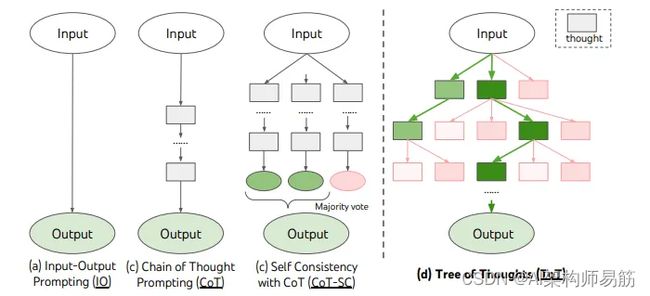LangChain 11实现思维树Implementing the Tree of Thoughts in LangChain’s Chain
思维之树( Tree of Thoughts ToT)是一个算法,它结合了普林斯顿大学和谷歌DeepMind在本文中提出的大型语言模型(LLMs)和启发式搜索。看起来这个算法正在被实现到谷歌正在开发的多模式生成AI Gemini中。
现在,让我们简要地谈谈 ToT(思维树)的思维过程。
在通常的 CoT(思维链)方法中,LLM(语言模型)倾向于在解决问题时线性地进行思考,如果在这个过程中出现错误,它们倾向于沿着错误的标准继续进行。
相比之下,在 ToT(思维树)方法中,LLM 在每个思维阶段都对自己进行评估,并及早停止低效的方法,转而采用替代方法。
代码实现
在LangChain的Chain中实施此项工作时,我利用了以下视频发布者提供的提示。简单地解释一下这个过程,首先生成广泛的想法,然后评估每个想法,深入探讨,并选择最有成功前景的想法。
PromptTemplate用于定义Tree of Thoughts提示的树形结构,每个步骤都实现了链。
from langchain.chains import LLMChain
from langchain.llms import OpenAI
from langchain.prompts import PromptTemplate
from langchain.chat_models import ChatOpenAI
template ="""
Step1 :
I have a problem related to {input}. Could you brainstorm three distinct solutions? Please consider a variety of factors such as {perfect_factors}
A:
"""
prompt = PromptTemplate(
input_variables=["input","perfect_factors"],
template = template
)
chain1 = LLMChain(
llm=ChatOpenAI(temperature=0, model="gpt-4"),
prompt=prompt,
output_key="solutions"
)
template ="""
Step 2:
For each of the three proposed solutions, evaluate their potential. Consider their pros and cons, initial effort needed, implementation difficulty, potential challenges, and the expected outcomes. Assign a probability of success and a confidence level to each option based on these factors
{solutions}
A:"""
prompt = PromptTemplate(
input_variables=["solutions"],
template = template
)
chain2 = LLMChain(
llm=ChatOpenAI(temperature=0, model="gpt-4"),
prompt=prompt,
output_key="review"
)
template ="""
Step 3:
For each solution, deepen the thought process. Generate potential scenarios, strategies for implementation, any necessary partnerships or resources, and how potential obstacles might be overcome. Also, consider any potential unexpected outcomes and how they might be handled.
{review}
A:"""
prompt = PromptTemplate(
input_variables=["review"],
template = template
)
chain3 = LLMChain(
llm=ChatOpenAI(temperature=0, model="gpt-4"),
prompt=prompt,
output_key="deepen_thought_process"
)
template ="""
Step 4:
Based on the evaluations and scenarios, rank the solutions in order of promise. Provide a justification for each ranking and offer any final thoughts or considerations for each solution
{deepen_thought_process}
A:"""
prompt = PromptTemplate(
input_variables=["deepen_thought_process"],
template = template
)
chain4 = LLMChain(
llm=ChatOpenAI(temperature=0, model="gpt-4"),
prompt=prompt,
output_key="ranked_solutions"
)
我们使用“SequentialChain”连接这四个链条。一个链条的输出成为下一个链条的输入。
from langchain.chains import SequentialChain
overall_chain = SequentialChain(
chains=[chain1, chain2, chain3, chain4],
input_variables=["input", "perfect_factors"],
output_variables=["ranked_solutions"],
verbose=True
)
print(overall_chain({"input":"human colonization of Mars", "perfect_factors":"The distance between Earth and Mars is very large, making regular resupply difficult"}))
输出
{
"input": "human colonization of Mars",
"perfect_factors": "The distance between Earth and Mars is very large, making regular resupply difficult",
"ranked_solutions": {
"Ranking_1": {
"Justification": "Using In-Situ Resource Utilization is the most promising solution due to its potential to provide the necessary resources for a Mars colony and reduce the need for resupply missions from Earth. The medium initial effort, implementation difficulty, and potential challenges are outweighed by the high probability of success and 70% confidence level.",
"In_Situ_Resource_Utilization_ISRU": {
"Pros": "This solution could provide the necessary resources for a Mars colony and reduce the need for resupply missions from Earth.",
"Cons": "ISRU is technically challenging and would require significant investment in research and development.",
"Initial_Effort": "Medium. This would require the development of new technology and the establishment of infrastructure on Mars.",
"Implementation_Difficulty": "Medium. ISRU is a complex task that requires advanced technology.",
"Potential_Challenges": "Technical difficulties, high costs.",
"Expected_Outcomes": "If successful, ISRU could provide a steady supply of resources for a Mars colony.",
"Probability_of_Success": "High. ISRU is already being tested by NASA and other space agencies.",
"Confidence_Level": "70%"
}
},
"Ranking_2": {
"Justification": "Building a self-sustaining colony is a promising solution due to its potential to make the Mars colony self-sufficient. However, the high initial effort, implementation difficulty, and potential challenges make it less promising than the first solution. The medium probability of success and 60% confidence level also contribute to its ranking.",
"Building_a_Self_Sustaining_Colony": {
"Pros": "This solution could make the Mars colony self-sufficient, reducing the need for resupply missions from Earth.",
"Cons": "Building a self-sustaining colony is a complex task that requires advanced technology and a lot of resources.",
"Initial_Effort": "High. This would require the development of new technology and the establishment of infrastructure on Mars.",
"Implementation_Difficulty": "High. Building a self-sustaining colony is a complex task that requires advanced technology.",
"Potential_Challenges": "Technical difficulties, high costs.",
"Expected_Outcomes": "If successful, a self-sustaining colony could reduce the need for resupply missions from Earth.",
"Probability_of_Success": "Medium. While there are significant challenges, there is also a lot of interest in building a self-sustaining colony on Mars.",
"Confidence_Level": "60%"
}
},
"Ranking_3": {
"Justification": "While asteroid mining has the potential to provide a steady supply of resources for a Mars colony, the high initial effort, implementation difficulty, and potential challenges make it a less promising solution compared to others. The medium probability of success and 50% confidence level also contribute to its lower ranking.",
"Terraforming_Mars": {
"Pros": "This solution could make Mars more habitable for humans, reducing the need for life support systems and making the colony more self-sufficient.",
"Cons": "Terraforming is a long-term process that could take centuries or even millennia. It would also require a massive amount of resources and energy.",
"Initial_Effort": "Extremely High. Terraforming would require a massive amount of resources and energy.",
"Implementation_Difficulty": "Extremely High. Terraforming is a long-term process that could take centuries or even millennia.",
"Potential_Challenges": "Technical difficulties, high costs, time scale.",
"Expected_Outcomes": "If successful, terraforming could make Mars more habitable for humans.",
"Probability_of_Success": "Low. Terraforming is a theoretical concept and has never been attempted before.",
"Confidence_Level": "20%"
}
}
}
}
最后,我认为不仅仅使用提示中的思维树,而且将其引入到代理人的规划过程中,可以提高工具选择和规划的准确性。
参考
https://medium.com/@astropomeai/implementing-the-tree-of-thoughts-in-langchains-chain-f2ebc5864fac
